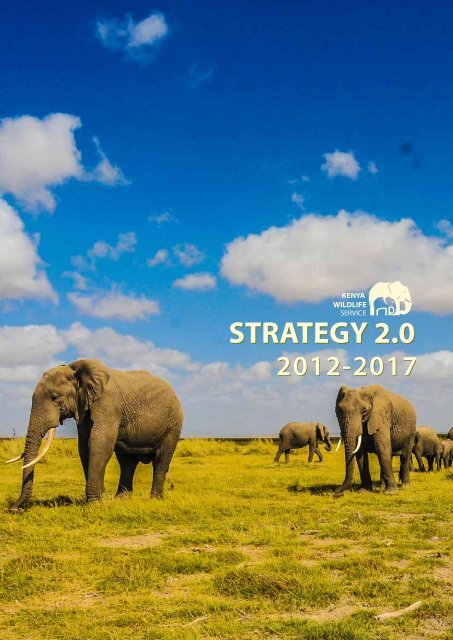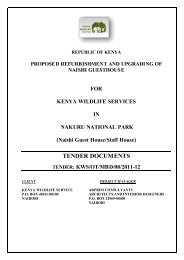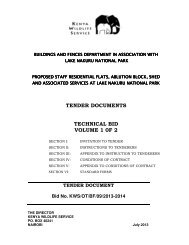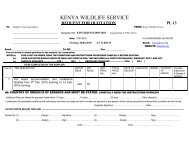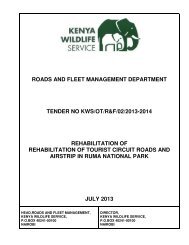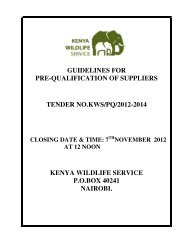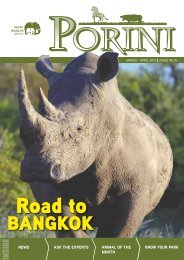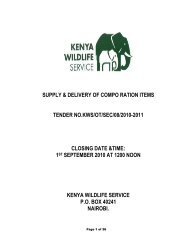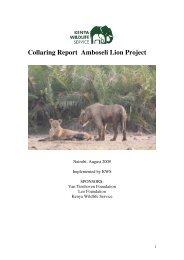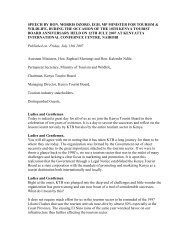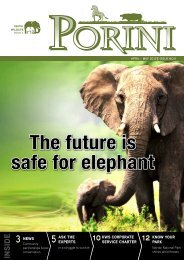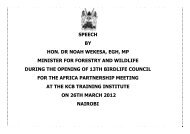KWS Strategic Plan 2012 - 2017 - Kenya Wildlife Service
KWS Strategic Plan 2012 - 2017 - Kenya Wildlife Service
KWS Strategic Plan 2012 - 2017 - Kenya Wildlife Service
- No tags were found...
You also want an ePaper? Increase the reach of your titles
YUMPU automatically turns print PDFs into web optimized ePapers that Google loves.
STRATEGY 2.0<strong>2012</strong>-<strong>2017</strong>i
CONTENTSForeword 2Glossary 3AcronymsBalanced Score Card Definitions1 About <strong>Kenya</strong> <strong>Wildlife</strong> <strong>Service</strong> 62 Mission, Vision and Core Values 73 <strong>KWS</strong> Strategy Story 8<strong>KWS</strong> Strategy House 94 2008 - <strong>2012</strong> <strong>Strategic</strong> <strong>Plan</strong> Reflections 105 Strategy Themes 126 Situational Analysis 136.1 PESTLE Analysis 136.2 SWOT 146.3 Customer/Stakeholder Analysis 157 Corporate Strategy Map 177.1 Objective Summary 187.2 Broad Objectives and Initiatives 208 Corporate Balanced Score Card 229 Financial Forecast 3010 Cascading, Monitoring and Evaluation 3111 Structure to Deliver Strategy 2.0 3212 Corporate Structure 331
FOREWORD<strong>KWS</strong> STRATEGY 2.0: “Preserve the Core and Stimulate Progress”As we launch our five-year plan <strong>2012</strong>-<strong>2017</strong>, we look back and celebrate years of hard work and sacrifices thathave helped conserve a wildlife heritage like no other for future generations. Powered by our past successesand desirous of improving on our inadequacies, we have developed a new roadmap termed <strong>KWS</strong> Strategy 2.0,a strategic plan which we believe will bring us optimum efficiency, accountability and success in our quest forconservation excellence.This strategy is a culmination of many consultative forums both within and outside <strong>KWS</strong>, careful evaluation ofour customer and stakeholder needs, our capabilities and our resources - financial and human. It focuses onpreserving our core values, while adapting our initiatives and operating practices to an ever-changing world. Ourstrategy’s theme is therefore a magical amalgamation of preservation of the core and stimulation of progress.Our strategic plan focuses on three key themes: conservation stewardship, people excellence, and collaborativepartnerships. The themes are informed by our core competencies, but our strategy is to strive for excellence. Wehave aligned the plan with <strong>Kenya</strong>’s national development blueprint, Vision 2030, by cascading the blueprint’sstrategic objectives and identifying our contribution. The strategy derives initiatives from these objectives andallocates resources for realising them. We shall focus on the “who” - our people; not just any people but the rightpeople for the responsibility of conserving our wildlife heritage. We shall endeavour to measure more, sharemore information and best practices and welcome more partners in our pursuit of conservation excellence.An important aspect of <strong>KWS</strong> has always been our capacity to adapt to new threats (be they security, financial, ordwindling community support as a result of resource pressure), and to reinvent and transform ourselves in orderto attain higher standards of excellence. Similarly, this strategic plan is intended to be flexible; a living documentsubject to continuous review, and fine-tuned to meet emerging challenges. However, our commitment tocontinuously earn the respect and support of <strong>Kenya</strong>ns and the world at large as we conserve and manage aunique and vulnerable resource of national and global significance remains constant.In the wake of numerous challenges - climate change, regional insecurity, natural calamities such as droughtsand floods, upsurge in wildlife crime, volatile economy and political instabilities – Strategy 2.0 helps set the stagefor us to do what we are mandated do: conserve <strong>Kenya</strong>’s wildlife heritage.We thank all our internal and external stakeholders who have contributed to the development of this strategy,the outstanding team that spearheaded its development, and our staff whose dedication and talents will ensureits realisation.2 Strategy 2.0
GLOSSARYACRONYMSAbbreviationBOTBSCCITESCBO’sCOYACTFCWSEIAEMCAGEFGOKICTISOKNPTKWCA<strong>KWS</strong><strong>KWS</strong>TIM & EMDGsMOU’sMTPNEMANESNGO’sNSWPAMUPAPFPA’sPCPESPESTLEPPPSOPsSPSSWOTWCMDMeaningBoard of TrusteesBalanced Score CardConvention on International Trade of Endangered SpeciesCommunity Based OrganisationsCompany of the Year AwardConservation Trust FundCommunity <strong>Wildlife</strong> <strong>Service</strong>Environmental Impact AssessmentEnvironmental Management and Co-ordination ActGlobal Environmental FundGovernment of <strong>Kenya</strong>Information and Communication TechnologyInternational Organization for Standardization<strong>Kenya</strong> National Parks Trustees<strong>Kenya</strong> <strong>Wildlife</strong> Conservancies Association<strong>Kenya</strong> <strong>Wildlife</strong> <strong>Service</strong><strong>Kenya</strong> <strong>Wildlife</strong> <strong>Service</strong> Training InstituteMonitoring & EvaluationMillennium Development GoalsMemorandum of UnderstandingMedium Term <strong>Plan</strong>National Environmental Management AuthorityNational Environmental SecretariatNon-Governmental OrganisationsNairobi Safari WalkProblem Animal Management UnitProtected Area <strong>Plan</strong>ning FrameworkProtected AreasPerformance ContractingPayment for Ecosystem <strong>Service</strong>sPolitical, Economic, Social-cultural, Technological, Legal & Environmental FactorsPublic Private PartnershipStandard Operating ProceduresSector Perfomance StandardsStrengths, Weaknesses, Opportunities & Threats<strong>Wildlife</strong> Conservation and Management Department3
BALANCED SCORE CARD DEFINITIONSMission: What we are about; our purpose; what we doVision: Our picture of the future; what we want toaccomplish in the futureCore Values: Our guiding principles; what we believein, principles and philosophy at the centre of ourorganizationStrategy: How we intend to accomplish our Vision; anapproach, or “game plan”Perspectives: Different views of our organization;performance dimensions; what performance lenses weuse to evaluate results<strong>Strategic</strong> Themes: Main focus areas for our organization;the organization’s “Pillars of Excellence”, used to focusstaff effort on accomplishing the vision<strong>Strategic</strong> Results: Desired outcome for the main focusareas of <strong>KWS</strong><strong>Strategic</strong> Objectives: This is a continuous improvementactivity that must be performed to get resultsStrategy Map: The “Big Picture” of how we create valuethat demonstrates the cause‐effect relationshipsamong the objectives that make up our strategyPerformance Measures & Targets: Indicators of past andfuture performance, which show how successful wewere or how successful we will be in future<strong>Strategic</strong> Initiatives: High impact projects designed tosignificantly impact strategic performance4 Strategy 2.0
1ABOUT KENYAWILDLIFE SERVICEThe <strong>Kenya</strong> <strong>Wildlife</strong> <strong>Service</strong> is a State corporationestablished by an Act of Parliament, <strong>Wildlife</strong> (Conservationand Management) CAP 376 with the mandate to conserveand manage wildlife in <strong>Kenya</strong>, and to enforce related lawsand regulations. The Act spells out the functions of <strong>KWS</strong>as follows:• Formulating policies and guidelines for conservation,management and utilization of all types of fauna andflora, excluding domestic animals• Stewardship of national parks and reserves, includingsecurity for visitors and wildlife within and outsideprotected areas• Providing advice to the national government, countygovernment, and land owners on best methods ofwildlife conservation and management• Mandated to license, control and supervise all wildlifeconservation and management activities outsideprotected areas• Providing wildlife conservation education and extensionservices to create public awareness• Conducting and coordinating research activities in thefield of wildlife conservation and management anddisseminate information• Capacity building for wildlife conservation andmanagement• Administering and coordinating international protocols,conventions and treaties regarding wildlife in all itsaspects<strong>KWS</strong> manages approximately 8 % of the total land massin <strong>Kenya</strong> that consists of 23 national Parks, 31 nationalreserves and 6 national sanctuaries, 4 marine nationalparks and 6 marine national reserves. There are also 154field stations for management of wildlife outside theprotected areasWater: <strong>KWS</strong> is directly responsible for conservingthree of the five critical water towers in <strong>Kenya</strong> namelyMt. <strong>Kenya</strong>, Aberdare and Mt. Elgon. The organisationis also involved in protecting and restoring the Mauforest in collaboration with other national agencies.Energy: 70% of <strong>Kenya</strong>’s electricity supply is generatedfrom rivers that emanate from <strong>KWS</strong> managed NationalParks (Mt. <strong>Kenya</strong>, Aberdare and Mt. Elgon NationalParks) and geothermal reservoirs situated in the Hell’sGate ecosystemFisheries: <strong>KWS</strong> manages five marine protected areas(Mombasa, Kisite Mpunguti, Malindi, Watamu andKiunga Marine Reserve) that contain critical marinehabitats which include coral reefs and mangroves.These habitats are important breeding grounds formarine organisms that support the local fisheries.Environmental: By protecting habitat and wildlife, <strong>KWS</strong>also conserves genetic resources that could be used todevelop new or improved food crops, medications,and other products. For instance, wild plants relatedto food crops may have genes that increase drought,flood or salt tolerance. Biotechnologists can use suchgenes to make important crops more resilient.National Security: <strong>KWS</strong> is a uniformed and disciplinedservice, contributing to national security.Transport: As an agent of the <strong>Kenya</strong> Roads Board, <strong>KWS</strong>maintains roads within and outside protected areas.International Conventions: <strong>Kenya</strong> is a signatory to anumber of environmental conventions and protocols.As the designated national authority on wildlife, <strong>KWS</strong>is called upon to interpret international conventions,adapt them to local conditions, and implement themin <strong>Kenya</strong>.1.1 Link to Other Sectors<strong>KWS</strong> also contributes to the national economy in thefollowing key sectors:Tourism: <strong>Wildlife</strong> is the major product of tourism in<strong>Kenya</strong>, accounting for 90% of the Safari tourism and75% of the total national tourism earnings.6 Strategy 2.0
2MISSION, VISION ANDCORE VALUESMISSIONSustainably conserve, manage, and enhance <strong>Kenya</strong>’s wildlife, its habitats, and provide a wide range of public uses incollaboration with stakeholders for posterityVISIONSave the last great species and places on earth for humanityCORE VALUESPassion, Professionalism, Innovation, and Quality7
3<strong>KWS</strong> STRATEGYSTORYStrategy 2.0 aims at moving the organization from goodto great and builds on the strengths of the good resultsfrom the previous strategic plans.Our shared vision is informed by the need to “save thelast great species and places on earth for humanity”.Achieving our mission and delivering customer andstakeholder value depends on successfully executingthree priority areas of our strategy, namely: ConservationStewardship, People Excellence, and CollaborativePartnerships. All our initiatives are aligned to thesestrategic focal areas.The strategic objectives we have set will be measuredthrough customer and stakeholder satisfaction, financialsustainability, efficient processes, and skilled andmotivated workforce. Satisfying our customers andstakeholders is enabled when we mobilize resources andoptimally use them for conservation.Improving and aligning our intangible assets and ourorganization’s readiness to improve critical processesdepends on having the people with the right attitudeand capacity, and aligning their aspiration to our strategicobjectives.Executing this strategy and achieving our strategicresults will depend on engaged leadership at all levels,interactive communication among all employees,and strong adherence to our core values of passion,professionalism, innovation and quality.8 Strategy 2.0
3.1 <strong>KWS</strong> STRATEGY HOUSEDeveloping a strategy can be compared to buildingcustom house. The mission, vision, customer needsmake up the roof of the house, the strategic results arelike the roof lintel, while the <strong>Strategic</strong> themes makeup the “pillars of the house”. The perspectives are the“different layers of blocks” of the house and foundationis engaged leadership, and core values.MISSIONSustainably conserve, manage,and enhance <strong>Kenya</strong>’s wildlife, its habitats, and providea wide range of public uses in collaboration with stakeholders for posterityVISIONSave the last great species and places on earth for humanitySTRATEGIC RESULTSEnhanced ecological integrity, Improved wildlife industry governance,Enhanced collaboration with our customers and stakeholders, Reduced humanwildlife conflict, Strengthened law enforcement and security, Great image and brand.Customer/StakeholderFinancialInternal ProcessCONSERVATIONSTEWARDSHIPPEOPLEEXCELLENCECOLLABORATIVEPARTNERSHIPSLearningand GrowthPASSION, PROFESSIONALISM, INNOVATION AND QUALITYShared vision + Bold, well executed strategy + Efficient communication and processes + Motivated Staff9
42008-<strong>2012</strong> STRATEGICPLAN REFLECTIONS<strong>KWS</strong> <strong>Strategic</strong> <strong>Plan</strong> 2008-<strong>2012</strong> was developed usingthe balanced score card methodology. The strategicplan emphasis was to focus on people, image andtechnology as the pillars of excellence. It was gearedtowards propelling the organisation into becoming acentre of excellence in wildlife conservation. Most ofthe set targets were attained and specific achievementsinclude the following:STRATEGIC OBJECTIVE ACHIEVEMENT VARIANCESEnhance collaboration withcustomers and stakeholders• Increased customer base by 30%• More communities embracedwildlife conservation as a landuse option.Strengthen law enforcement • Positive attitude towards wildlifeconservation• Well equipped and skilledworkforce• Effective and efficient wildlifesecurityEnhance financialsustainability• Total revenue increased by 68%• Park entry tarrifs reviewed for allmajor parks• Safari card revenue system fullyoperationalized and rolled out to6 additional parks.• SUN financial system devolvedto the 8 conservation areasAnd all major parks to enhancefinancial management• Animal adoption programofficially launched andoperationalized• International resourcemobilization raised funds forForensic/DNA Laboratory andone Cessna aircraft• New revenue streams identifiedand operationalEnhance <strong>Service</strong> Delivery • Attained ISO certification andput systems in place for effectiveservice delivery• Implemented Safaricard revenuecollection system• The target of tripling thecustomer numbers within fiveyears was not achieved• Outreach programme needsenhancement• Need for sophisticatedequipment e.g. night vision.• Endowment Fund has not beenofficially launched• Second tier parks not fullyexploited to enhance revenue• Customer relationshipmanagement system forrealtime tracking of customercomplaints not in place• Agency selling has not yet beenactualized10 Strategy 2.0
STRATEGIC OBJECTIVE ACHIEVEMENT VARIANCESReduce human wildlife conflict • Response time to reportedcases in human wildlife conflictreduced from 24hours to 12hours• <strong>Wildlife</strong> compensation processshortened from 6 months to 3monthsImprove wildlife industrygovernance• <strong>Wildlife</strong> policy and bill passedthrough cabinet and redraftedby Attorney General• Conservancies associationformed (KWCA)• Capacity building &harmonization of conservancyrangers training at LawEnforcement Academy, Manyani• Database for 120 wildlifeconservancies done andfunctional• 120 private and communityconservancies establishedEnhance ecological integrity • Rhino and elephant strategiesdeveloped• Forensic laboratory established• Laikipia National Parkestablished• 300 acres buffer for NairobiNational Park secured• Two management plans forShimba and KiBoDo (Kiunga,Boni & Dodori) developedStrengthen and modernizeinstitutional capacity• New rangers and other staffrecruited• Payroll strategy implemented• <strong>KWS</strong> has become an employer ofchoice and this has enabled theorganization to achieve a highlevel of skills retention• Reference point for excellence inmanagement• New ICT equipment procured• Intranet and internet servicesenhanced• BSC cascaded to departmentaland Park/Station level• Use of BSC in managementreporting• Emergency Management Unitstrengthened• Force modernization programinitiated• Various recognition awards inCOYA achieved• <strong>KWS</strong>TI Academic Boardinaugurated• <strong>Wildlife</strong> compensation still notreal time• Bill not presented in parliament• Some conservancy rangers havenot been trained• Not all Protected Areas assessed• Not all wildlife corridors havebeen secured• Some management plans notyet completed• Optimum staffing not realized• Some processes not automated• Safari card system roll out to all• parks not achieved.• Appraisals and rewards yet tobe fully integrated with thescorecard system• Individual BSC not developed11
5STRATEGYTHEMES<strong>Strategic</strong> themes are the key areas which we must focusto accomplish desired results. Each theme has a desiredoutcome or strategic result. The organization, in the durationof this strategic plan, will focus on three areas namelyconservation stewardship, which is our core mandate; peopleexcellence, which aims at having the right people with theright attitude and capacity; and collaborative partnershipssince wildlife management can only be achieved with thesupport of other stakeholdersThe focal areas in previous strategic plans have been thebuilding blocks that have supported our growth. In thestrategic plan 2008-<strong>2012</strong>, the focus was on people as ourmost valuable resource, image for strengthening the <strong>KWS</strong>brand and leveraging on technology for opening newopportunities. <strong>Strategic</strong> plan 2005-2010 focused on useof science and information to drive park managementactivities, and ensuring market presence to generaterevenue to support conservation.<strong>2012</strong> - <strong>2017</strong>ConservationStewardshipPeopleExcellenceCollaborativePartnerships2008 - <strong>2012</strong>People Technology Image2005 - 2010 Science Information Market12 Strategy 2.0
6SITUATIONANALYSIS6.1 PESTLE AnalysisA number of factors may affect the organization in its efforts to accomplish its mission and vision. These factorshave been considered in coming up with this strategic plan. They include the following:FACTORPolitical factorsEconomic factorsSocio cultural factorsTechnological factorsLegalEnvironmentELEMENTS• National stability• New constitution• Relationships with neighboring countries• County governments• Unpredictable exchange rates• Escalating cost of living• Uncertain monetary and fiscal policies• Unpredictable tourism trends• Corruption• Demographic changes• Poverty levels• Changing consumption patterns• Changes in land use patterns• Corruption• Emerging technologies• E‐commerce and internet• Changing <strong>Wildlife</strong> Act• Conflicting legislation by other sectors• Disparities in regional policies and laws• International agreements• New constitution‐Land commission• County governments• Climate change• Changing land use patterns• Weakness in implementing EMCA• Lack of strong policies for ecosystem protection13
6.2 SWOTSTRENGTHS AND OPPORTUNITIES (ENABLERS)• <strong>KWS</strong> has the National legal mandate forconservation• Unique and diverse wildlife and landscapes• Well established wildlife protection units• Clearly defined partnerships• Good infrastructure• Strong leadership and governance systems• Clearly defined Protected Area <strong>Plan</strong>ning Framework(PAPF)• Local and international goodwill and recognition• Very dynamic staff• Potential to attract financial support and otherresources from development partners• Supportive partners government and communitysupport• Resource mobilization potential• Potential for further tourism development• Commercialization of some of the business units• Protection of ecosystem services• Payment for ecosystem services• Technological advancementWEAKNESSES AND THREATS (PAINS)• National mandate is too broad• Inadequate finances and over reliance on externaltourism• Inadequate human resources• Incomplete biodiversity inventory• Inadequate knowledge• Inadequate risk management strategy• Underutilization of information• Lack of an engagement policy with partners14 Strategy 2.0
6.3 Customer/Stakeholder AnalysisExamples ofstakeholders• Tourists• Hoteliers• Tour operators• Transport industryBehaviours We Wantto See• Customersatisfaction andretention• Productappreciation• Partnerships,our servicescomplement theirsTheir Needs (Value TheyAre Seeking)• Product diversity• Good infrastructure• Efficient and effectiveservice• Visitor safety• <strong>Wildlife</strong> to sustainvalue chainResistanceIssues• Product price• Park policies• They demand valuefor money• Policies• ProductsTheir Influence• Revenue• Policies• Visitation• Revenue• <strong>Service</strong> delivery• Communities• Privateconservancies• Employees• Politicians• African range states• Donors/development agencies• MEA’s Secretariats• Law enforcementagencies• Government regulators• Banks and insurancecompanies• Schools and learninginstitutions• Government• Governmentagencies• Local authorities• Positive attitudetowards wildlifeconservation• Satisfaction,appreciation,partnerships andrelationships• Goodwill andsupport• Satisfaction,• Appreciation,• Partnerships andrelationships• Goodwill andsupport• Harmonisedpolicies• Resource sharing(economic andsocial empowerment)• Protection fromwildlife destruction• <strong>Service</strong>• Revenuegeneration• Conservationstewardship• Good corporategovernance• Policies• Accountability• <strong>Wildlife</strong> as a landuse option• Conservationfailures• Accountability• Conservationstandards• Policy• Funding• Revenue• Goodwill• Publicity• Policy• Funding• Support• Revenue• Goodwill• Publicity• Media• Appreciation• Partnerships andrelationships• Goodwill andsupport• Conservationstewardship• Conservationfailures• Policy• Funding• Support• Revenue• Goodwill• Publicity15
Examples ofcustomersBehaviours We Wantto SeeTheir Needs (Value TheyAre Seeking)ResistanceIssuesTheir Influence• Suppliers• Appreciation• Partnerships andrelationships• Conservationstewardship• Prompt payments• Bureaucracy• Procurementpolicy• Funding• Goodwill andsupport• Quality products• Value for money• Timely delivery• Clear procurementguidelines• Transparencyin award of tenders/contracts• Support• Revenue• Goodwill• Publicity16 Strategy 2.0
7CORPORATESTRATEGY MAPThe corporate strategy map is a cause and effect diagram thatshows how one perspective leads to the next and ultimately,delivery of our mandate. Learning and growth will equip ourstaff with requisite skills to re-engineer our internal businessprocesses. Efficient processes will lead to prudent financialmanagement and ultimately better services to customersand stakeholders, which will enhance wildlife conservation.Stakeholder/Customer MissionSustainably conserve, manage, and enhance <strong>Kenya</strong>’s wildlife, its habitats, and providea wide range of public uses in collaboration with stakeholders for posterityC2: Enhance speciesconservation & their habitatsC5: Enhance partnershipswith customers& stakeholdersEnhance <strong>Wildlife</strong> ConservationC6: RetaincustomersC1: Strengthen vision2030 deliveryC3: Reduce humanwildlife c tC7: GrowcustomersC8: Strengthen lawenforcement & securityC4: Improve wi ldlifeindustry governanceC9: Enhance corporatesocial responsibilityEnhance Financial SustainabilityInternalProcess FinancialF1: Enhance resource mobilization F2: Enhance f inancial management F3: Increase revenueEnhance Quality <strong>Service</strong> DeliveryI1: Improve service quality I2: Improve business process I3: Improve risk managementOrganizationalCapacityL1: Enhance recruitment &placement of human capacityL4: Improve technology& knowledge systemsStrengthen Institutional capacityL5: Improve alignment ofemployees to corporateobjectivesL2: Enhancemulti - skillingL6: EnhanceteamworkL3: Improve performancemanagementL7: Enhance creativityand innovation17
7.1 OBJECTIVE SUMMARYCUSTOMER AND STAKEHOLDER PERSPECTIVEStrengthen vision2030 deliveryEnhance speciesconservation andtheir habitatsComply with vision 2030 projects for tourism and wildlife, sectormedium term plans, sector performance standards and governmentperformance contract requirementsManage our habitats better for ecological integrityReduce Humanwildlife conflictHuman wildlife conflict cases are reduced to a level conforming tothe sector performance standard requirementsImprove wildlifeindustry governanceStreamlined wildlife industry that is effectively managedEnhance partnershipwith customers andstakeholdersDevelop new partnerships and quality of existing partnerships isimprovedRetain customersEnsure that that the organization does not loose customers tocompetitorsGrow customersEnsure that the customer base will grow from the current levelsStrengthen law enforcementand security<strong>Wildlife</strong> inside and outside protected areas are safeEnhance CSRHealthy ecosystems, social equity and good governanceFINANCIAL PERSPECTIVEEnhance resourcemobilizationSufficient resources are mobilized for sustainable conservationEnhance financialmanagementOrganization is in compliance with all statutory and regulatoryrequirements and internal policies and proceduresIncrease revenueNew revenue streams are developed through diversified productsand services18 Strategy 2.0
INTERNAL PROCESSESImprove service quality<strong>Service</strong>s offered meet stakeholder requirementsImprove business processesEfficient processes for service delivery are put in place and areeffectively managedImprove risk managementProactive approach to risk mitigationLEARNING AND GROWTHStreamline recruitmentProper match of jobs and skillsEnhance multi‐skillingStaff are able to perform multiple tasks within their areas of workImprove performancemanagementEnsure rewards are matched with performanceImprove technology andknowledge managementEnable employees to leverage on technology and share knowledgeabout the organization with othersImprove alignment ofemployees to corporateobjectivesEnsure that whatever the employee does is aligned to the corporateobjectivesEnhance teamworkEnsure employees work with others to achievethe goals of the organizationEnhance creativityand innovationEnsure employees come up with newideas that would enable them to perform their work in abetter way19
7.2 BROAD OBJECTIVES AND INITIATIVES1. Strengthen and modernize institutionalcapacityInitiatives1.1. Development of a knowledgemanagement system1.2. Succession planning and capacitybuilding1.3. Upgrade equipment and infrastructure1.4. Staff appraisal and reward system1.5. Implementation of innovation policy1.6. Inculcate teamwork and synergy2. Enhance quality service deliveryInitiatives2.1. Monitoring of service level agreementsimplementation2.2. Maintenance of quality managementsystems2.3. Automate, upgrade and harmonizeinternal processes2.4. Identify and manage strategic risks3. Enhance financial sustainabilityInitiatives3.1. Diversify and strengthen revenuestreams3.2. Introduce and implement costreduction measures3.3. Intensify fundraising activities3.4. Adopt green technology4. Enhance wildlife conservationInitiatives4.1. Increase space for wildlife4.2. Implement wildlife policy and law4.3. Maintain ecological integrity4.4. Security (collaborative, modernization,strengthen)4.5. Use of technology in biodiversity andsecurity management4.6. Funding for existing strategies4.7. Formulate, review and implementecosystem management plans4.8. Formulate and implement endangeredand vulnerable species strategies4.9. Domesticate MEA (MultilateralEnvironmental Agreements)5. Enhance partnerships with customers andstakeholdersInitiatives5.1. Capacity-build communities andstakeholders5.2. Manage human-wildlife conflict5.3. Evaluate impact of Corporate SocialCitizenship5.4. Organize the wildlife industry20 Strategy 2.0
PERSPECTIVESTRATEGICOBJECTIVESC1.StrengthenVision 2030DeliveryCORPORATE BALANCED SCORE CARDMEASURES TARGETS INITIATIVES BUDGET (KES 000’ <strong>2012</strong> – <strong>2017</strong>) OWNER<strong>2012</strong>/13 2013/14 2014/15 2015/16 2016/17i. Participate in development oftargets for Vision 2030 MediumTerm <strong>Plan</strong> 2013 – 2018(Environment, Water & SanitationSector, Security Sector, EconomicSector – Tourism)7,5007,500 7,5007,5007,500AllDivisionsii. Develop Sector PerformanceStandards in liaison with otherGovernment Agencies3,0003,0003,000AllDivisionsCompliancewith Vision2030 MediumTerm <strong>Plan</strong>s(MTP) 2013-2018 & SectorPerformanceStandards(SPS)100%iii. Align Vision 2030, SectorPerforming Standards, Strategy 2.0.and Performance Contractingiv. Coordinate M&E and Reportingto Vision 2030 Delivery Secretariat,Performance ContractingDepartment, Board of Trustees and<strong>KWS</strong> Management.3,5005003,5005003,5005003,5005003,500500Strategy& ChangeStrategy& Changev. Cascade Vision 2030, SectorPerforming Standards, <strong>KWS</strong> 2.0and Performance Contracting1,2001,2001,2003,600 1,200Strategy& Changevi. Develop, Negotiate &Implement PerformanceContracts3,6003,6003,600 3,6003,600AllDivisionsCUSTOMER/STAKEHOLDER22 Strategy 2.0
PERSPECTIVESTRATEGICOBJECTIVESC2.EnhanceSpeciesConservation & theirHabitatsCORPORATE BALANCED SCORE CARDMEASURES TARGETS INITIATIVES BUDGET (KES 000’ <strong>2012</strong> – <strong>2017</strong>) OWNER<strong>2012</strong>/13 2013/14 2014/15 2015/16 2016/17i. Develop ecological integritycomposite indexii. Carry out Baseline Surveys onEcological Integrity5,0005,0005,000iii. Identify and document KeyEcosystem Hotspots and enhancetheir connectivity4,500 4,500 4,500 4,500 4,500iv. Formulate and ReviewEcosystem Management <strong>Plan</strong>s8,0008,0008,0008,000 8,000Ecosystemperfomance/integrityindexX+10%v. Institutionalize Payment ofEcosystem <strong>Service</strong>s (PES)vi. Undertake Conservation andManagement of Water CatchmentAreasvii. Undertake Conservation andManagement of Wetlands ofInternational Importance (Ramsarsites and other wetlands)viii. Establish Community LevelWetlands Conservation3,0001,5004,5283,0001,5004,5283,0001,5003,0004,528 4,5283,0001,500 1,5004,5283,000 3,000 3,000 3,000 3,000x. Rehabilitate Degraded Habitats 10,000 10,000 10,000 10,000 10,000BiodiversityResearch &Monitoring/<strong>Wildlife</strong> &Community<strong>Service</strong>/Corporateservicexi. Designate new Wetlands ofInternational Importance (Ramsar Sites)xii. Engage stakeholders inBeach Managementxiii. Manage Invasive Species inNational Parks, Reserves & AdjacentAreasxiv. Identify and Map <strong>Wildlife</strong>Corridors and Dispersal Areasxv. Formulate and ImplementEndangered Species Conservationand Management Recovery <strong>Plan</strong>s1,000 1,000 1,000 1,000 1,00036,000 36,000 36,000 36,000 36,0007,100 7,100 7,100 7,100 7,1003,000 3,000 3,000 3,000 3,00030,000 40,000 480,000xvi. Nurture Orphaned <strong>Wildlife</strong> 20,000 20,000 20,000 20,000 20,000CUSTOMER/ STAKEHOLDER23
C2 ContinuedPERSPECTIVESTRATEGICOBJECTIVESC2. EnhanceSpeciesConservation& theirHabitatsC3. ReduceHuman<strong>Wildlife</strong>ConflictCORPORATE BALANCED SCORE CARDMEASURES TARGETS INITIATIVES BUDGET (KES 000’ <strong>2012</strong> – <strong>2017</strong>) OWNER<strong>2012</strong>/13 2013/14 2014/15 2015/16 2016/17No of ViableEcosystemsMaintained8xvii. Roll out Conservation Anthemand Conservation Dayxviii. Improve Adaptation andMitigate impacts of Climate change in the <strong>Wildlife</strong> Sectorxx. Institutionalize Go-Green EconomyActivities in the <strong>Wildlife</strong> Sector10,000 5,000 13,000 10,000 5,000 13,000 10,000 5,000 13,000 10,000 5,000 13,000 10,0005,00013,000xxi. Undertake Environmental auditsand EIA of Projects4,000 4,000 4,000 4,000 4,000xxii. Establish Forensic andGenetic/DNA Laboratories15,000 15,000 15,000 15,000 15,000xxiii. Implement NationalBio-Prospecting Strategy1,500 1,500 1,500 1,500 1,500xxiv. Secure and utilize Land Asset 50,000 50,000 50,000 50,000 50,000BiodiversityResearch &Monitoring/<strong>Wildlife</strong> &Community<strong>Service</strong>/Corporateservice% reductionin conflictcases10i. Support Establishment ofConservancies and link Communitieswith Investors and Donorsii.Conduct Education and Awareness 40,000 50,000 55,000 66,000 89,000iii. Engage Media for Education andCreation of Awarenessiv. Engage Stakeholders andCommunities in wildlife management15,000 18,000 21,600 25,920 31,10490,000 106,000 111,000 124,000 133,000v. Identify areas for <strong>Wildlife</strong> Barriers 2,500 2,600 3,000 3,800 4,500vi. Construction and maintain <strong>Wildlife</strong>Barriersvii. Train and equip Problem AnimalManagementviii. Create <strong>Wildlife</strong> ConservanciesForum, build their capacity and carryout joint patrols and data collectionx. Engage & Collaborate withStakeholders to secure <strong>Wildlife</strong>Corridors and Dispersal Areas30,000 30,000 30,000 30,000 30,000100,000 120,000 150,000 150,000 180,00033,000 41,580 52,381 66,012 83,17611,000 14,300 18,590 24,167 31,41720,000 20,000 20,000 20,000 20,000<strong>Wildlife</strong> &Community<strong>Service</strong>/Strategy &Change/Security/Corporateservicexi. Develop Governance indicatorsCUSTOMER/ STAKEHOLDER24 Strategy 2.0
PERSPECTIVESTRATEGICOBJECTIVESC4. Improve<strong>Wildlife</strong>IndustryGovernanceC5. EnhancePartnershipswithCustomers &StakeholdersC6. RetainCustomersC7. GrowCustomersCORPORATE BALANCED SCORE CARDMEASURES TARGETS INITIATIVES BUDGET (KES 000’ <strong>2012</strong> – <strong>2017</strong>) OWNER<strong>2012</strong>/13 2013/14 2014/15 2015/16 2016/17i. Adopt, Domesticate andDisseminate relevant InternationalConventions, Treaties & Agreements43,000 50,30158,86368,86980,577% Compliance100ii. Develop and domesticate <strong>Wildlife</strong>Research and Utilization Guidelinesiii. Align <strong>Wildlife</strong> Laws and Policy toNew Constitutioniv. Lobby for enactment of newwildlife billv. Establish Engagement platform for<strong>Wildlife</strong> Conservancies, <strong>Wildlife</strong> NGO'sand other Stakeholdersvi. Enforce wildlife utilizationstandardsvii. Develop Protected AreasManagement Effectiveness Tools12,000300,0005,0004,00040,00012,000300,000300,000300,000300,00010,000 12,000 14,000 15,500 18,000BiodiversityResearch &Monitoring/<strong>Wildlife</strong> &Community<strong>Service</strong>/Corporateservice% CustomersatisfactionIndex(X + 5)i. Conduct Outreach to Partners 50,000 68,400 77,800 99,486 117,000ii. Conduct Public Awareness andCommunication10,000 15,200 16,000 18,000 19,200iii. Conduct Media Briefings 6,000 7,200 8,640 10,368 12,442i. Introduce Loyalty Programs 100,000 100,000 100,000 100,000 100,000% Repeatcustomers70% Growth 5ii. Conduct Customer SatisfactionSurvey and Implement Findingsiii. Increase Consumer CommunicationCampaignsiv. Improve <strong>Service</strong> Qualityi. Enhance Internal Customer <strong>Service</strong>and Marketing5,000 5,000 5,000 5,000 5,00010,000 12,000 14,400 17,280 20,73625,000 30,000 36,000 43,200 51,840ii. Launch Agency Management 25,000 30,000 36,000 43,200 51,840All DivisionsCUSTOMER/ STAKEHOLDER25
PERSPECTIVECORPORATE BALANCED SCORE CARDSTRATEGICMEASURES TARGETS INITIATIVES BUDGET (KES 000’ <strong>2012</strong> – <strong>2017</strong>) OWNEROBJECTIVES<strong>2012</strong>/13 2013/14 2014/15 2015/16 2016/17F1. EnhanceResourceMobilizationF2. EnhanceFinancialManagement% increasein fundsmobilized% Saving PerAnnum5010F3. Increase % Increase inRevenue 10RevenueI1. Improve<strong>Service</strong>Quality% Reductionin Cycle Time10i. Increase in Mobilize GovernmentSubventionsii. Introduce and undertakeFundraising and Flagship Eventsiii. Diversify Resource MobilizationStreams11,000 12,100 13,310 15,641 16,105i. Implement Efficiency measures onCost Reduction and Savingsii. Comply with set BudgetaryProvisionsiii. Link the Process of Budgeting toPerformance Target Setting12,500 2,000 15,0002,000 12,5002,000 2,000 2,000iv. Devolve automated financialservices7,000 8,000 7,000 7,000v. Cashflow Managementi. Introduce New Products and fees 200,000 300,000 200,000 300,000 200,000ii. Conduct Asset Inventory 3,000 3,300 3,630 3,993 4,392iii. Operationalize Special Purpose 150,000 12,000Vehicleiv. Diversify Revenue Streams50,000 50,000v. Carry out Park Branding & Rebranding50,000 50,000i. Implement and Operationalize <strong>KWS</strong>Customer <strong>Service</strong> Charterii. Undertake Continuous Auditsv. Enhance Supply Chain management4,500 4,5004,5004,50038,000 47,500 59,375 74,219 92,77310,000 12,000 14,400 17,280 20,7364,000 4,000 4,000 4,000 4,000iii. Implement <strong>Service</strong> LevelAgreements1,200 1,200 1,200 1,200 1,200iv. Maintain ISO Certification 4,000 4,800 5,760 6,912 8,2944,500All DivisionsStrategy &Change,Finance &AdministrationINTERNALPROCESSESFINANCIAL26 Strategy 2.0
I1 ContinuedPERSPECTIVESTRATEGICOBJECTIVESI1. Improve<strong>Service</strong>QualityI2. ImproveBusinessProcessI3. ImproveRiskManagementCORPORATE BALANCED SCORE CARDMEASURES TARGETS INITIATIVES BUDGET (KES 000’ <strong>2012</strong> – <strong>2017</strong>) OWNER<strong>2012</strong>/13 2013/14 2014/15 2015/16 2016/17% Reductionin Cycle Time%Compliance% Reductionin Riskincidences/Uncertainties1010010vi. Develop, Cascade and ImplementOrganizational policiesvii. Develop & Implement CustomerRelationship Management Strategy10,000 12,000 14,400 17,280 20,736viii. Implement Gemba Kaizen4,500 4,500 4,500 4,500 4,500i. Maintain and Upgrade ICT Systems 30,000 30,000 30,000 30,000 30,000ii. Align Performance Contracts toRespective Functions12,500 12,500iii. Automate PerformanceManagement Systems3,500iv. Undertake Process Audits 4,500 4,500 4,500 4,500 4,500v. Emplement Monitoring andEvaluation6,000 7,200 8,640 10,368 12,442vi. Improve Infrastructure within Parks 800,000 960,000 1,152,000 1,382,400 1,658,880vii. Automate Ticketing800,000 960,000 1,152,000 1,382,400 1,658,800i. Develop and Implement EnterpriseManagement Policy and framework13,000 15,000ii. Identify and Manage <strong>Strategic</strong> Risks 150,000 180,000 216,000 259,200 311,040iii. Strengthen Revenue Inspection 150,000 180,000 216,000 259,200 311,0402,500Strategy &Change,Finance &AdministrationCorporate<strong>Service</strong>/Strategy &Change/Human Capital/DirectorsAll DivisionsINTERNAL PROCESSES27
PERSPECTIVESTRATEGICOBJECTIVESL1.StreamlineRecruitmentProcessL2. EnhanceMulti SkillingL3. ImprovePerformanceManagementL4. ImproveTechnology& KnowledgeSystemsCORPORATE BALANCED SCORE CARDMEASURES TARGETS INITIATIVES BUDGET (KES 000’ <strong>2012</strong> – <strong>2017</strong>) OWNER<strong>2012</strong>/13 2013/14 2014/15 2015/16 2016/17i. Develop Talent ManagementPrograms12,000 12,000 12,000 12,000 12,000% Match ofSkill and JobPlacementNo. ofEmployeesTrained inother Skills1001additionalskill/employeeii. <strong>Strategic</strong> Placement of HumanCapacityiii. Review Organizational Structure tosupport <strong>KWS</strong> Strategyiv. Develop an effective Succession<strong>Plan</strong>, Management and SupervisoryTrainings.v. Recruit and Train Rangersi. Conduct Training and Development;Mentoring & Coaching Programme,Job Rotation, Role Play10,000 12,000 14,40040,000 48,000 57,60040,00017,28069,12020,73682,94448,000 57,600 69,120 82,94420,000 24,000 11,000 11,000 11,000Human Capital% Compliancewith SetTargets% Level ofAutomation10050%i. Review and Implement PerformanceManagement Systemii. Undertake and implementCompetency Development3,000 3,450 3,968 4,563 5,247iii. Develop Internal PerformanceContracts1,500 1,725 1,984 2,281 2,624i. Upgrade Equipment & Infrastructure 150,000 150,000 150,000 150,000 150,000ii. Deploy Modern Security Equipment 40,000 29,000iii. Develop Knowledge ManagementSystemsHuman CapitalCorporate<strong>Service</strong>LEARNING AND GROWTH28 Strategy 2.0
PERSPECTIVESTRATEGICOBJECTIVESL5. ImproveAlignmentof Employeesto CorporateObjectivesL6. EnhanceCreativity &InnovationCORPORATE BALANCED SCORE CARDMEASURES TARGETS INITIATIVES BUDGET (KES 000’ <strong>2012</strong> – <strong>2017</strong>) OWNER<strong>2012</strong>/13 2013/14 2014/15 2015/16 2016/17i. Carry out Employee and WorkEnvironment Survey8,000 9,600 11,520 13,8247,871ii. Cascade Balanced Score Cards 5,000 6,000 7,200 8,64010,368EmployeeSatisfactionIndex(x+5)iii. Conduct Training NeedsAssessmentiv. Conduct Employee Training andExposure Training Evaluationv. Develop and implement teamrewards300 300 300 3003006,700 6,700 6,700 6,700 6,700800 800800900800Human Capital/Strategy &Changevi. Improve Internal Communication15,000 18,000 21,600 25,920 31,104vii. Improve Employee Welfare9,000 10,800 12,960 15,552 18,662No. of IdeasImplemented 5viii. Undertake Team Building3,000 3,000 3,000 3,000 3,000i. Develop and Implement InnovationPolicy 7,000ii. Create Idea Bank and innovationmatrixiii. Conduct sensitisation Workshopsiv. Reward Ideas Implemented3,600 3,600 3,600 3,600800,000 960,000 1,152,000 1,382,40010,000 12,000 14,400 17,28015,00020,736v. Implement Innovative Ideas 5,000 5,000 5,000 5,000 5,000TOTAL BUDGET 4,530,862 5,036,548 5,543,322 6,334,826 7,566,0823,600Strategy &ChangeLEARNING AND GROWTH29
8FINANCIALFORECASTFor this strategy to be successfully implemented <strong>KWS</strong>will have to expand its revenue base to support theactivities outlined in this plan. The following areas are thehighlights that have been taken into consideration in theprojections.1. Conservation fee will be revised during theimplementation of this strategic plan resulting in15% increase in park entry fees.2. There will be a 15 % increase in visitation.3. New revenue streams will be introduced.4. Endowment fund principle target is estimated togenerate a return of 10% annually.5. Salaries and allowance upgrade by 10% annually.6. Expenditure expected to grow at 10% annually.7. Government funding of capital expenditure isexpected to increase by at least KShs. 500 million peryear.INCOME AND EXPENDITURE FORECAST KSHS “000”INCOME 2011/12 <strong>2012</strong>/13 2013/14 2014/15 2015/16 2016/17Park Entry Fee 3,975,057 4,770,068 5,724,082 6,868,898 8,242,678 9,891,214Accommodation Facilities 159,002 198,753 248,441 310,551 388,188 485,236Other income 313,011 322,401 335,297 352,062 366,144 380,790GoK Subvention 2,001,300 2,501,625 2,800,000 2,800,000 3,000,000 3,000,000Grants 600,000 600,000 600,000 600,000 600,000 600,000Endowment fund Interest 40,000 50,000 100,000 100,000 150,000 200,000OVERALL INCOME 7,088,370 8,442,847 9,807,820 11,031,511 12,747,011 14,557,239TOTAL Recurrent Expenditure 5,982,716 6,580,988 7,239,086 7,962,995 8,759,294 9,635,224Total Capital Expenditure 2,261,000 2,202,000 2,116,000 2,882,000 3,289,576 3,754,792OVERALL SURPLUS/(DEFICIT) -1,155,346 ‐340,141 452,733 186,516 698,140 1,167,22330 Strategy 2.0
9CASCADING, MONITORINGAND EVALUATION9.1 CASCADINGStrategy 2.0 will be disseminated at three levels, stating from the corporate level from where it will be cascadedto the department, park or station and then to the individual. Respective levels will develop their score cards andmonitor their objectives, measures, and strategic initiatives against allocated budgets and timelines.DIVISIONALCOORDINATIONCORPORATE SCORECARDTIER 1PARK/ STATION SCORECARDSTIER 2DEPARTMENTAL SCORE CARDTIER 2AREACOORDINATIONINDIVIDUAL SCORE CARDSTIER 39.2 MONITORING AND EVALUATIONAfter BSCs have been established for multiple levels of the organization, a strategy monitoring and evaluationprocess will be put in place to ensure that performance is reviewed and analyzed on a periodic basis. This strategywill further be subjected to a mid‐term and end‐term external review. The process will take into account emergentissues, why targets were not met, and changes in the environment that affect this plan.9.3 PERFORMANCE APPRAISAL AND BUDGETINGEmployees’ appraisal will be aligned to this strategy and linked to performance scorecards. Supervisors will conductannual appraisals and objectively analyze the employees’ performance and contribution to the service based onindividual scorecard. Budgets will also be strategy‐based, derived from initiatives developed from the strategicobjectives31
10STRUCTURE TO DELIVERSTRATEGY 2.0The organizational structure to drive this plan will largely be determined by the plan. The following are the guidingprinciples for the envisioned structure;1. Need to strengthen devolution initiated in theprevious plan2. Need to make the headquarters lean.3. Need to strengthen the oversight role to ensurecompliance to standards4. Aligning <strong>KWS</strong> structure to the Constitution5. Strengthen the delivery of Vision 20306. Need to provide for organizational growth andstrategic direction7. Rationalized span of control at all levels8. Need to strengthen Monitoring and Evaluationfunction9. Address new institutional arrangements envisionedin the expected new <strong>Wildlife</strong> Act10. Address need for semi - autonomy andcommercialization of some functions – <strong>KWS</strong>TI andAir wing32 Strategy 2.0
WILDLIFE SERVICECORPORATE STRUCTURE11KENYAProductivityImprovement &QualityAssuranceInformation &CommunicationTechnologyArea AssistantDirectorMonitoring andEvaluation33
34 Strategy 2.0
The Director<strong>Kenya</strong> <strong>Wildlife</strong> <strong>Service</strong>P. O. BOX 40241 - 00100 Nairobi <strong>Kenya</strong>ISDN: +254 - 20 - 3991000; +254 - 20 - 3992000Wireless:+254 - 20-2379407-15Mobile: +254 - 735 663 421, +254 - 736 663 400,+254 - 726 610 508, +254 - 726 610 509,+254 - 726 610 533Fax: +254 - 20 - 603792Email: kws@kws.go.keWebsite: www.kws.go.ke<strong>Kenya</strong> <strong>Wildlife</strong> <strong>Service</strong> <strong>KWS</strong><strong>Kenya</strong> <strong>KWS</strong><strong>Kenya</strong> <strong>Kenya</strong> _<strong>Wildlife</strong>36 Strategy 2.0


